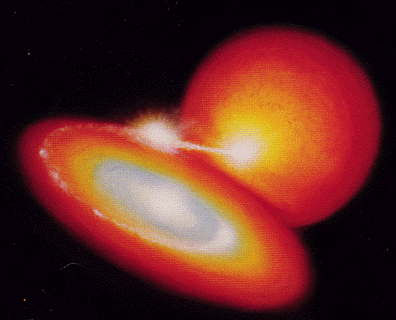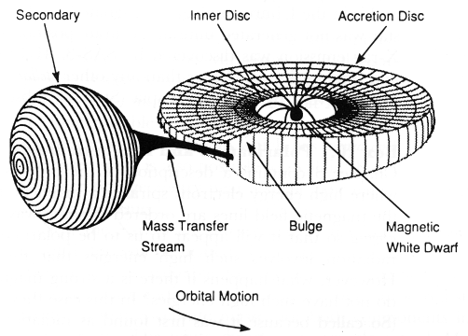What's on This PageWhat are CVs?CVs are binary systems that consist of an normal star and a white dwarf. They are typically small - a typical binary system is roughly the size of the Earth-Moon system - with an orbital period in the range 1-10 hrs. The companion star, a more or less normal star like our Sun, loses material onto the white dwarf by accretion.
In the fusion-dominated phase, there are currently two different categories of CVs: In the accretion-dominated phase, CVs can be categorized into several different types:Classical NovaeA classical nova occurs when material accreting onto the surface of a white dwarf star's surface begins an unstable thermonuclear fusion reaction. Mass transfer will occur gradually between novae explosions and it will be accreted onto the white dwarf's surface at a low rate, generating only weak X-ray emission. The nova outburst will increase the apparent brightness of the binary star system by ten thousand to a million times (an increase in stellar magnitude of 10 to 15). They are hypothesized to recur, though with recurrence time scales of 10,000 years, no known novae recurrence have been observed.In the X-ray regime, classical novae have been observed many times. There is no clear pattern in their light curves over a period of years or decades. Several sources have been observed in the period of days to months after the nova explosion to be weak X-ray emitters (1033 - 1034 ergs/s, as compared to an Eddington luminosity limit of around 1038 ergs/s for a one solar mass white dwarf). One explanation for this weak emission is shock heating of the circumstellar envelope in the white dwarf's environment from new material expelled by the nova explosion. At least two sources (GQ Mus and V1974 Cyg) have been observed to develop a super soft source like emission on the time scales of years. On the other hand, of 26 novae which exploded in the decade prior to the ROSAT All-Sky Survey, only GQ Mus was observed to have become a super soft source. All other sources surveyed in the All-Sky Survey exhibited only upper limits. Novae that are close enough for sensitive observations are detected in hard X-rays decades after their eruptions; this is presumably due to on-going accretion onto the white dwarf. Examples of these nearby systems with hard X-ray emission include Pup 91, QU Vul, and CP Pup.
In the low mass X-ray binary (LMXB) model of SSSs, the lower temperature spectra of these systems with comparison to their standard LMXB cousins is due to an extended cloud around the neutron star or black hole. This cloud Compton scatters the original higher temperature X-ray photons and the larger observed blackbody radius (of the order 104 km) is simply the radial size of this cocoon of matter. The compact object would need to have a weak and small magnetic field structure: a strong or extended field would disrupt the cloud. Theoretical calculations of the spectra for spherical accretion onto a non-magnetized neutron star seem to match observations to date reasonably well. In the white dwarf scenario, the observed blackbody radii is simply the size of the white dwarf star itself with nuclear fusion occurring on its surface. If accretion occurs onto the white dwarf surface at low rates, fusion will be sporadic and violent, resulting in classical novae type explosions. If accretion is at a high rate, the white dwarf will acquire a red-giant-like atmosphere. Continuous nuclear fusion on the dwarf star surface would be possible only for a narrow range of accretion rates of the order of 10-7 solar masses per year. For relatively massive white dwarfs (0.7 - 1.2 solar masses), the luminosities of nuclear fusion and temperature would match the ROSAT observations. This raises the distinct possibility that such objects could eventually exceed the Chandrasekhar limit, making them the progenitors for Type Ia supernovae. Although both interpretations are still valid, the weight of evidence is strongly in favor of the white dwarf model. In particular, the ASCA SIS spectra of SSS RX J0925.7-4578 and Cal 87 show characteristic edges that are expected to form in the white dwarf atmosphere.
The principal source of electromagnetic radiation in a dwarf nova system is the accretion disk. The companion star to the white dwarf is a low mass red dwarf star filling its Roche lobe with matter streaming onto the accretion disk through the inner Lagrange point. The gas stream from the L1 point impacts the accretion disk and creates a hot spot. Matter gradually transports through the accretion disk onto the surface of the white dwarf, generating temperatures which make the disk much hotter and brighter than either star. The dwarf nova outburst and other related phenomenon are believed to be caused by variations in the accretion rates through the disk. Material reaching the white dwarf surface through the disk must pass through a violent transition region, called the boundary layer: it is here that the X-rays in dwarf novae originate. This is shown dramatically by the recent observations of X-ray eclipses in HT Cas; the eclipse duration is the same as that of the white dwarf as determined by optical observations. The sharpness of the transitions into and out of the eclipse proves that the X-ray emitting region has a size comparable to that of the white dwarf.
In a polar system such as the prototype AM Her, matter will overflow the Roche lobe of the companion star. However, the white dwarf possesses a strong magnetic field, which prevents the formation of a accretion disk. Instead, the overflowing material is directed by the magnetic field structure until it impacts on the surface of the white dwarf at its magnetic pole. Until impact, the material essentially free falls, thus reaching substantial velocities which are seen in the optical spectra. The collision generates a shock wave which is the source of hard (energetic) X-rays. Hard X-rays emitted in the direction of the white dwarf from the shock wave above its surface heat the local area around the pole sufficiently for the pole to become a source of intense soft (less energetic) X-rays. Since soft X-rays are coming only from the pole, rotation of the white dwarf can occult the X-ray source on its surface. Polars are generally much stronger sources of soft X-rays than hard X-rays. Most likely, this is due to uneven matter streaming. Clumps in the accretion flows would most likely cause energy to also be liberated deep within the atmosphere of the white dwarf, resulting in more soft X-ray emission. The strong magnetic field will also lock the orientation of the white dwarf relative to the companion, so that orbital and rotational periods are identical. X-ray emission from polar systems is entirely due to the accretion column and its impact, so in quiscient times when matter is not accreting onto the system, the entire system is much dimmer. Spectral lines measured at these times show the Zeeman effect which measures the magnetic field strength in the megagauss range.
AM Her type systems are distinct from all other CVs in that they completely lack an accretion disk. However, in systems which have less strong magnetic fields, or wider separations between the companion and white dwarf, an accretion disk can form. As material migrates inwards in the disk, it may eventually encounter a magnetic field strong enough to control the flow of material, at which point matter would instead stream from the inner edge of the disk along magnetic field lines onto the pole of the white dwarf. Such a system would therefore be expected to be a source of hard X-rays from the shock at the magnetic poles. CVs which possess both an accretion disk and magnetic fields which disrupt the inner edge of the disk are known as intermediate polars. Intermediate polars, either due to weaker magnetic fields or wider star separations, will not necessarily have orbital and spin rates locked. Observed systems have longer orbital periods than polars, which given that the systems have comparable masses verifies their wider separation. Whether such systems also have weaker magnetic fields is an area of active research.
IMAGES |
By Mission |
Stars |
HEASARC Home | Observatories | Archive | Calibration | Software | Tools | Students/Teachers/Public Last modified: Monday, 11-Dec-2017 11:11:42 EST |





